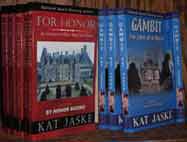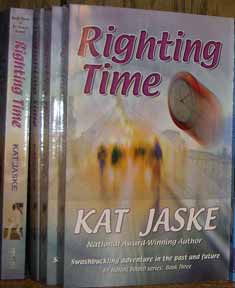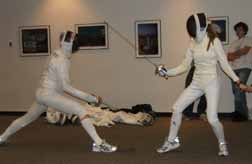
Can one woman save a
country? TWICE?
Can she do it as a lady musketeer and fencer in 17th-century France, AND
can she and the musketeers grant a hero's final wish?


Righting Time
Book Three of BY HONOR BOUND
by Kat Jaske
What if Jala really is from the future
and the fate of her future does depend on convincing Laurel and the 17th-century
musketeers of that truth? Read Excerpts
|
 Kat
Jaske has had several articles published in many articles databases on
the Internet. Kat
Jaske has had several articles published in many articles databases on
the Internet.
Ezinearticles
Article Dashboard
Ideamarketers
Articleteller
Goarticles
Articlealley

 Article
1. Creative Fiction Writing Workshop: Starting
Your Story. Article
1. Creative Fiction Writing Workshop: Starting
Your Story.
How do I get started? Where do I get ideas?
Get ideas from virtually any common, ordinary situation. Get out of your
house to see real people and the real world and ideas will come from the
most random places. Be sure to jot down these ideas so as not to forget
them.
Furthermore, be thinking about what kind of a story you want to write
so that you can slant your descriptions in that direction.
1. First, simply DESCRIBE A NORMAL SCENE
you witnessed in a store:
The man put the socks down, took the girl by the hand and walked out.
2. Now, CHANGE the sentence. Make it involve
more of the senses. Play around with how different words can completely
change the mood of the situation. Use adjectives and adverbs:
The man forcefully threw his purchase at the Target clerk, grabbed the
5-year-old girl roughly by the arm and jerked her toward the door.
3. ADD ANOTHER SENTENCE or three to more
completely describe what happened next, or its results. Use adjectives
so you more fully portray the characters. Vary your sentence length—sometimes
long, sometimes short. CHANGE the event. It’s fiction. Be creative:
She continued screaming at the top of her lungs all the way out. The hem
of the girl’s tattered Sunday dress soaked up the bright red blood
dripping from her broken lip. The man pushed his long brown hair roughly
from his eyes, wiped his calloused hand on his dirt-stained pants, and
dragged her resisting, squirming form into the rusty 1980’s Ford.
4. ADD SOME DIALOGUE, SOME QUOTES and CONFLICT.
Add a TWIST so that what the reader first thought is changed a little:
“Shut up. Shut up. Do you hear me!” he yelled as he buckled
her seatbelt and tried ineffectually to wipe her face gently with a tissue.
“Don’t you ever do that again! I saw you put candy in your
pocket. We don’t do that, ever. That’s stealing, and I will
pay for whatever we need. No child of mine will ever steal anything, ever.”
Here, we have him buckling her seatbelt and gently wiping her face. Those
are not the actions of an uncaring father. You have now grabbed the reader’s
attention so he or she wants to know more. Things are too interesting
and too confusing for the reader to stop now.
Use proper grammar in the dialogue to show he is educated, and use poor
grammar to show lack of education, or, perhaps, low intelligence or even
frustration level. How people say things is very revealing about them,
their ideas, their moods, etc.
5. EXPAND THE DESCRIPTIONS of what’s
going on AROUND THIS SCENE. Describe what others are saying in the store.
Use dialogue for their conversation:
The clerk stood still staring at the candy the man had pulled from little
Megan’s pocket. Jonathan was a proud father and always talked about
how he could take care of his family.
“Did you see that?” the older man said in a disapproving tone
as he plunked his shampoo and potato chips on the counter. “People
like that shouldn’t have kids.”
Marie shook her head and commented, “I have never seen him get that
angry before. Maybe I should have my manager call the police. But I don’t
want to get him in trouble. He is usually so kind, and I’ve seen
him a lot over the last two years, him and his handicapped son. You know,
the one who’s different.”
Now you have a great beginning for your story. It’s your turn to
keep writing.
Article 2. Creative Fiction Writing Workshop:
Character Development.
Would you recognize your characters if you ran into them on the street?
Answering a resounding “yes” to this question indicates you
have been able to develop solid, plausible characters.
Make your characters come alive, whether
in good or bad ways. Let them talk. This means using dialogue.
However, you need to also provide vivid descriptions of
the characters’ mannerisms or facial expressions or body expressions.
Your readers must be able to create a visual picture
of your characters, as well as hear what they are saying.
Pay particular attention to how your characters interact with other people
in the story. How they behave toward others reveals much about their character.
Are they kind? Abrupt? Intelligent? Funny? Weird? Concerned? Evil? Strong?
Controlling?
You need to convey these traits to
a reader in a way that will inspire your reader to love, hate, admire,
or feel SOMETHING about the people you have created.
------------
“And she hates you.”
“With a passion and what a passion.”
“And what have you done to earn such ire from such a young woman?”
Tonie seemed mildly amused by the man.
“I tried to force her to marry me. I shot
one of her oldest and dearest friends down in cold blood and killed him.”
He didn’t even pause for breath as he listed his catalog of worthy
accomplishments. “I betrayed my own brother. And I shot her lover
in front of her eyes. A pity Frederick William wouldn’t give up
on the man or he would have died. As it was it took him months to recover.
I guess you could say the woman has a personal vendetta
against me. Will there be anything else, madame?”
he concluded with a practiced politeness.
“Not at the moment.” Tonie left the room, Konrad on her heels.
She stopped long enough to pull Greg aside and give him instructions in
regard to the pursuit of one Laurel d’Anlass. “Ever try betraying
me, and I’ll kill the woman myself, Konrad.”
“I would expect nothing less. But, my lady Tonie, I highly recommend
you do not seek to threaten me.”
“Take it as a threat if you will, Konrad. But you have shown your
weakness, my dear.” Tonie’s barbed words struck with more
force than even she realized. “In that warped heart of yours you
love Laurel and could never kill her without dying yourself.
So don’t push me unless you want me to take all control
out of your hands and make you lose any possibility of ever possessing
that beautiful, young woman.”
------------
In the above scene from the coming book, Righting Time by Kat
Jaske, even though you have not read the book, you can discern much about
the characters. Note that Konrad is speaking rapidly and doesn’t
even pause for breath as he rattles off his list of worthy accomplishments.
He is polite, but it is not real. He has a “practiced” politeness.
These behaviors help the reader to instinctively dislike
the man. Readers quickly realize that Tonie is a killer since she is amused
by evil deeds and so easily states she will kill Laurel herself.
Who is in control here? Tonie or Konrad? Near the end you see that Tonie
controls this scene, but Konrad pushes back when she threatens him. These
two people are fighting to establish who is really in control.
Note also the double use of the word “passion.” Although one
would not normally use the same word twice so close in the same sentence,
this is much more powerful and descriptive than saying, “With a
great passion.”
Article 3. Creative Fiction Writing Workshop:
Using Quotation Marks and Other Punctuation
Don’t let dialogue and punctuation outsmart you.
Dialogue between characters is one great way to engage in character development.
Usage of quotes can become very complicated in your characters’
dialogue, but you don’t have to struggle with how to use quotes
along with commas, periods, capitalization, the em dash, the ellipses,
and other marks.
Use the templates below for models on how to use quotation marks, and
you will be a whiz at this in no time.
Your word processing program will probably use smart quotes. Example:
“I love cookies.” The quote marks curl toward the words. You
may set your word processor to use straight quotes if you prefer. Be sure
you are consistent and always use one or the other throughout your entire
writing.
1. Using the ellipses to show the thought trails
off, when the sentence is incomplete:
End with a blank, then the three dots, the quote, a blank.
“I, I, I . . .” he stuttered.
A non-quote new sentence follows: Capitalize the
new sentence.
“Still she’s reckless, and that temper of hers . . .”
Not to mention the prickly pride.
A new paragraph follows:
“I don’t know what to say, Aramis. They’re your best
friends, not my best friends. I’ve no right to tell them. But maybe
. . .”
2. Using the ellipses within quotes when the sentence
is complete:
A new sentence, within the same quote follows. Note
there is a period before the three dots.
“He has my father’s signet ring, and Papa never let that out
of his possession. . . . They murdered my father in Belgium.”
The quote sentence is complete and is followed
by a new non-quote sentence:
“And Uncle Porthos even took me on his horse. . . .” Suddenly,
the boy stopped as if realizing he had a crowd.
3. Quote starts the sentence; the “he said”
is in the middle, and then the quote continues:
Don’t capitalize the continued sentence.
“My father’s out of the country,” she began in a measured
tone, “and a lone woman could hardly welcome a group of strange
men to her home.”
4. Quote starts the sentence, ends with a comma
and quote and blank and the “he said.”:
Do not capitalize the word after the closing quote
unless it is a proper name or the word “I.”
“He will see you now,” the servant said, bowing as Athos thanked
him.
Quote ends with a question mark and is followed
by the “he said:”
Don’t capitalize the “he said” part.
“Do we have an agreement?” the unofficial leader of the group
asked.
5. Quote starts in the middle of the sentence:
Put a comma after the leading “he said.”
Have one blank, then the quotation mark, then the first word of the quote
capitalized.
He shrugged his shoulders and said, “It was just a possible explanation.
I know it’s not a very good one.”
6. Use the em dash to show a pause in the quote
that is all one sentence:
Use no spaces before or after the dash.
“You know what I really wish? I really wish you could find it in
your heart to trust me—to not always play the gentleman. However,
it’d be more than enough if you just decided to be your real self.”
Use the em dash to show one sentence trails off
and then a new sentence begins:
Capitalize the new sentence. Use one space after the closing quote.
“Yes, but—” She silenced him with a kiss.
“I think so, but—On second thought, it’s not true,”
he said.
Kat Jaske ©2006 All rights reserve.
|

Reviews <<<more
reviews ->>>
- "Some of the best stories and best written
books I have read in several years."
Mark Myers - storyteller - Ohio
- Selected by Las Vegas Green Valley High School for the 2006 Reading
Incentive Program
More reviews ->>>
Article 4. Creative Fiction Writing Workshop: Interaction
of the Character and the Story.
The author needs a framework, but his/her characters have some freedom within
the framework.
A good story must have a basic framework
to hang upon.
There are two basic approaches to framework creation. One
approach is to create a detailed outline
of the order of events in the story from the beginning to the end and
have the final product be a fully fleshed out version of the outline.
Another method is to have a basic overall picture of where the story will
go and some of the important events that will occur along the way, including
a rough idea of how the tale should end. In this second approach, the
story is given more freedom to unfold and the author may even surprise
himself or herself. In fact, in this approach the
author might well be writing to find out what happens.
Regardless of whether you are a storyteller who prefers a greater structure
on which to hang a story or whether you are a storyteller who prefers
more spontaneity, there will always be a dynamic
relationship, an interaction, between the tale that is being crafted and
the characters developed to inhabit that story and bring it to life.
Many beginning authors fall into the rigid mindset
that, “I am the author. I create the story. I know how I want my
story to end and what is going to occur along the way.” This isn’t
always true. Your characters may
sometimes have different ideas.
They have a certain amount of control over the story. This
is true regardless of which basic story framework style you choose to
follow.
As a good storyteller, you have endeavored to create your characters’
personalities in a detailed manner so that if someone ran into them on
the street that person would recognize the characters.
Based on the personality established for a given character,
one can predict how the character will react in most situations since
every person can be somewhat predictable.
Once you as an author have figured out this basic pattern
and you give the character a similar situation,
will she always react that same way? The answer surprises some
people. It is a resounding: Not always. Real
people are oftentimes inconsistent and will end up surprising you.
Therefore, to have a believable character, you must
make the character behave like a real person and allow him or her to sometimes
do the unexpected, or, otherwise, you have created a robot your
readers will not like. Therefore, don’t force the story on the character.
Sometimes the story will have to be adapted to fit the character.
Nevertheless, when you break the character’s general trends, it
absolutely must be believable. The event should not sound like
a false note that distracts the reader. At the same time, it is all right
to have some notes that stick out as long as they do not detract from
the work as a whole.
This is a balance you as a storyteller will have to practice
and play around with. But while playing around, remember just as you should
not force the story on the character, you should not force the character
on the story. Story and character interact and create
something bigger than either one alone.
This dynamic interaction is the magic of story creation that will inspire
your readers to visit your world frequently.
Buy books at big
discount->>>
Read book excerpts->>>
Read more articles->>>

Author Kat Jaske is a sport fencer. Her books feature musketeers, fencing
and sword fighting.
|